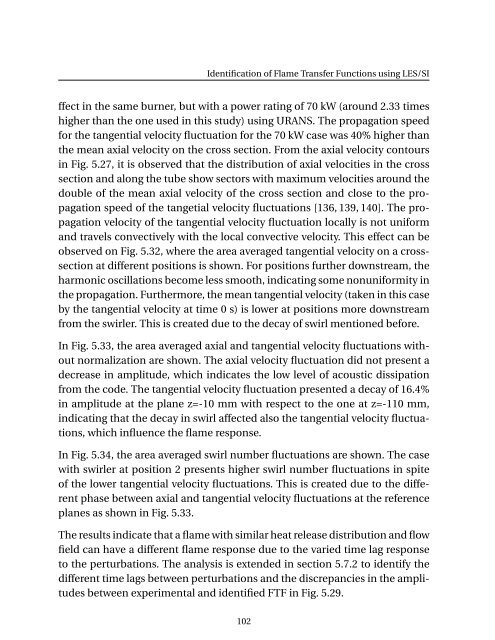Numerical Simulation of the Dynamics of Turbulent Swirling Flames
Numerical Simulation of the Dynamics of Turbulent Swirling Flames
Numerical Simulation of the Dynamics of Turbulent Swirling Flames
You also want an ePaper? Increase the reach of your titles
YUMPU automatically turns print PDFs into web optimized ePapers that Google loves.
Identification <strong>of</strong> Flame Transfer Functions using LES/SI<br />
ffect in <strong>the</strong> same burner, but with a power rating <strong>of</strong> 70 kW (around 2.33 times<br />
higher than <strong>the</strong> one used in this study) using URANS. The propagation speed<br />
for <strong>the</strong> tangential velocity fluctuation for <strong>the</strong> 70 kW case was 40% higher than<br />
<strong>the</strong> mean axial velocity on <strong>the</strong> cross section. From <strong>the</strong> axial velocity contours<br />
in Fig. 5.27, it is observed that <strong>the</strong> distribution <strong>of</strong> axial velocities in <strong>the</strong> cross<br />
section and along <strong>the</strong> tube show sectors with maximum velocities around <strong>the</strong><br />
double <strong>of</strong> <strong>the</strong> mean axial velocity <strong>of</strong> <strong>the</strong> cross section and close to <strong>the</strong> propagation<br />
speed <strong>of</strong> <strong>the</strong> tangetial velocity fluctuations [136, 139, 140]. The propagation<br />
velocity <strong>of</strong> <strong>the</strong> tangential velocity fluctuation locally is not uniform<br />
and travels convectively with <strong>the</strong> local convective velocity. This effect can be<br />
observed on Fig. 5.32, where <strong>the</strong> area averaged tangential velocity on a crosssection<br />
at different positions is shown. For positions fur<strong>the</strong>r downstream, <strong>the</strong><br />
harmonic oscillations become less smooth, indicating some nonuniformity in<br />
<strong>the</strong> propagation. Fur<strong>the</strong>rmore, <strong>the</strong> mean tangential velocity (taken in this case<br />
by <strong>the</strong> tangential velocity at time 0 s) is lower at positions more downstream<br />
from <strong>the</strong> swirler. This is created due to <strong>the</strong> decay <strong>of</strong> swirl mentioned before.<br />
In Fig. 5.33, <strong>the</strong> area averaged axial and tangential velocity fluctuations without<br />
normalization are shown. The axial velocity fluctuation did not present a<br />
decrease in amplitude, which indicates <strong>the</strong> low level <strong>of</strong> acoustic dissipation<br />
from <strong>the</strong> code. The tangential velocity fluctuation presented a decay <strong>of</strong> 16.4%<br />
in amplitude at <strong>the</strong> plane z=-10 mm with respect to <strong>the</strong> one at z=-110 mm,<br />
indicating that <strong>the</strong> decay in swirl affected also <strong>the</strong> tangential velocity fluctuations,<br />
which influence <strong>the</strong> flame response.<br />
In Fig. 5.34, <strong>the</strong> area averaged swirl number fluctuations are shown. The case<br />
with swirler at position 2 presents higher swirl number fluctuations in spite<br />
<strong>of</strong> <strong>the</strong> lower tangential velocity fluctuations. This is created due to <strong>the</strong> different<br />
phase between axial and tangential velocity fluctuations at <strong>the</strong> reference<br />
planes as shown in Fig. 5.33.<br />
The results indicate that a flame with similar heat release distribution and flow<br />
field can have a different flame response due to <strong>the</strong> varied time lag response<br />
to <strong>the</strong> perturbations. The analysis is extended in section 5.7.2 to identify <strong>the</strong><br />
different time lags between perturbations and <strong>the</strong> discrepancies in <strong>the</strong> amplitudes<br />
between experimental and identified FTF in Fig. 5.29.<br />
102
















